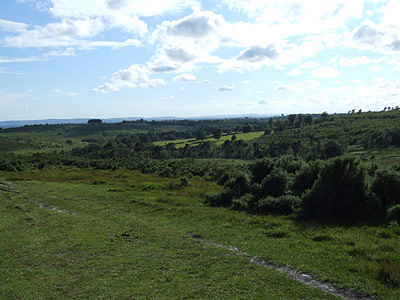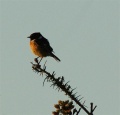Overview
Ashdown Forest is an Area of Outstanding Natural Beauty in the High Weald. It is situated between Crowborough, Nutley, Maresfield and Forest Row. Originally a deer hunting forest in Norman times, Ashdown Forest is now freely open to the public. It is a great place for walking and enjoying spectacular views over the Sussex countryside and is known the world over as the 'home' of Winnie-the-Pooh.
The Forest covers 6500 acres (2500 hectares), and over half of this is heathland. It makes up 2.5% of the UKs heathland which is a very important and rare habitat. The Forest Centre is the headquarters of the Conservators of Ashdown Forest who are responsible for the managing the Forest. Bird recording is conducted on the Forest by the Ashdown Bird Group who are not directly affiliated to the Forest Centre or Conservators.
To support a heathland the soil is very acidic, Ashdown Forest is based on a bed of sandstone with pockets of clay. Water collects and creates boggy areas which are exceptionally good for wildlife. Being elevated quite high above sea-level the area also attracts a lot of rainfall in the Winter months. Acid loving plants including heath bedstraw, heath-spotted orchid and bog asphodel can be found in many places as well as heathland moths including latticed heath and hawkmoths.
Photo by pjohnson
Winter view over Ashdown ForestPhoto by pjohnson
Stonechat image taken at "Spring Garden", Ashdown Forest
Birds
Notable and Rare Species
A Summary of a Year on Ashdown Forest
Birding on Ashdown Forest can be a thankless task, particularly in the Winter. Speaking of Winter, this is when we get our most notable species... Great Grey Shrike, which often gets reported on the SOS and Bird Guides websites. Other Winter species includes passing birds of prey like Hen Harrier, Merlin, Peregrine Falcon and Common Raven. Common Crossbill, Siskin, Lesser Redpoll and Brambling are present, some throughout the year, others only in Winter. If there is a good crop of berries Waxwings occasionally turn up.
In Spring the Forest is alive with bird song. Blackcap, Garden Warbler, Willow Warbler, Chiffchaff, Dartford Warbler, Greater Whitethroat, increasingly Lesser Whitethroat, Cuckoo, Tree Pipit, Yellowhammer, Skylark and Woodlark can be seen and heard on the Forest. Stonechats are present but their numbers have been dropping. Redstarts can be seen, the males using low branches in open pine woodland to sing. Spring is also a good time to catch birds heading north as the Forest provides a good stopping off point for migrants. Ring Ouzel, Wheatear, Yellow Wagtail and Hobby pass through and you may be lucky enough to see Common Buzzard or Red Kite drifting high across any wooded valleys.
In Summer things quieten down as the breeding season is in full swing. Most of the warblers will be present and a few birds of prey. Look out for early migrants like Whinchat. Spotted Flycatcher are sometimes seen along the edges where heathland meets woodland. In the evening crepuscular species including Nightjar and Woodcock begin their day.
In Autumn the Forest starts to wake up before the Winter and is a good time to look for migrants coming south. Meadow Pipit, Redwing, Mistle Thrush, Fieldfare all over-winter on the Forest and Dartford Warbler become more visible. If you're really lucky you may catch a glimpse of an Osprey heading towards Weir Wood reservoir.
Check-list
Birds you can see here include:
Grey Heron, Canada Goose, Mandarin, Mallard, Sparrowhawk, Buzzard, Kestrel, Hobby, Peregrine Falcon, Pheasant, Lapwing, Snipe, Woodcock, Black-headed Gull, Common Gull, Lesser Black-backed Gull, European Herring Gull, Great Black-backed Gull, Ferral Rock Dove, Stock Dove, Wood Pigeon, Collared Dove, Turtle Dove, Cuckoo, Tawny Owl, Nightjar, Swift, Green Woodpecker, Great Spotted Woodpecker, Wood Lark, Skylark, Sand Martin, Swallow, House Martin, Tree Pipit, Meadow Pipit, Grey Wagtail, Pied Wagtail, Wren, Dunnock, Robin, Redstart, Whinchat, Stonechat, Wheatear, Blackbird, Fieldfare, Song Thrush, Redwing, Mistle Thrush, Dartford Warbler, Lesser Whitethroat, Whitethroat, Garden Warbler, Blackcap, Chiffchaff, Willow Warbler, Goldcrest, Common Firecrest, Spotted Flycatcher, Long-tailed Tit, Marsh Tit, Coal Tit, Blue Tit, Great Tit, Nuthatch, Treecreeper, Jay, Magpie, Jackdaw, Rook, Crow, Raven, Starling, House Sparrow, Chaffinch, Greenfinch, Goldfinch, Siskin, Linnet, Redpoll, Crossbill, Bullfinch, Yellowhammer, Reed Bunting
Other Wildlife
There are plenty of Fallow and Roe Deer on the Forest -- to the dismay of many drivers who've hit them -- as well as Rabbits. There are a few Foxes and Badgers around the edges.
The Forest gets a few butterflies; most notably the Silver-studded Blue. Also Common Blue, Holly Blue, Red Admiral, Peacock, Comma, Speckled Wood and other common species.
Dragonflies and damselflies are present including Southern Hawker, Golden-ringed Hawker, Broad-bodied Chaser, Black-tailed Skimmer, Beautiful Damoiselle, Common Blue Damselfly, Azure Blue Damselfly and probably many more.
Photo by pjohnson
White Bell-Heather or Ling taken on Ashdown ForestPhoto by pjohnson
Round-Leaved Sundew on Ashdown ForestPhoto by pjohnson
Bog Asphodel growing in a wet flush on Ashdown Forest
Site Information
History and Use
There is a good history section on the Conservators website, links as follows:
Areas of Interest
Each of the car parks are different areas, although the habitat is generally similar, there are a few which can harbour some good spots.
Wrens Warren
Open heathland valley which is mainly short grassland after several fires and clearance work. The area is good for Tree Pipit, Stonechat and Nightjar. Along the wooded edges keep a look out for Redstart. This is a good area for butterflies.[Map]
Airstrip
As the name suggests it was an airstrip. The habitat has low heather and gorse and is surrounded by pines. Look out for Redpoll, Crossbill, Dartford Warbler and Cuckoo. There are a few dead trees which attract woodpeckers and the odd pond which attracts dragonflies.[Map]
Garden of Eden
A nice walk down a thick heather valley to a wooded stream at the bottom. This is where any passing Whinchats may stop to rest. Kestrel looking for Meadow Pipits can often be seen hovering over the heather. Warblers including Chiffchaff, Willow Warbler and Whitethroat sing from the trees near the bottom. At the stream itself Grey Wagtails and Pied Wagtails often hang around catching insects.[Map]
Access and Facilities
Access is straight-forward and should ideally be done by road if possible. The main facilities are at the Forest Centre.
Access By Car
Access is by road, using the numerous car parks available to walk out onto the Forest. The A22 cuts through the Forest running between Nutley and Forest Row, access to the Forest Centre is from this road, turning at Wych Cross traffic lights.
Access By Bus
Stagecoach Service 54 (becomes 261 from Uckfield onwards) Buses run from Eastbourne to East Grinstead via Uckfield. They stop at Chelwood Gate, Wych Cross and the Forest Centre.
Metrobus Service 291 East Grinstead to Tunbridge Wells, stopping at Forest Row and Hartfield.
Metrobus Service 270 East Grinstead to Haywards Heath, stopping at Forest Row, Wych Cross and Chelwood Gate.
Access By Train
Trains from London Bridge or London Victoria to East Grinstead are fairly regular.
Contact Details
The Forest Centre 01342 823583
Or use website links.
External Links
Maps
- Ashdown Forest on Streetmap
- Wren's Warren on Streetmap
- The Airstrip on Streetmap
- Garden of Eden on Streetmap
GSearch checked for 2020 platform.










